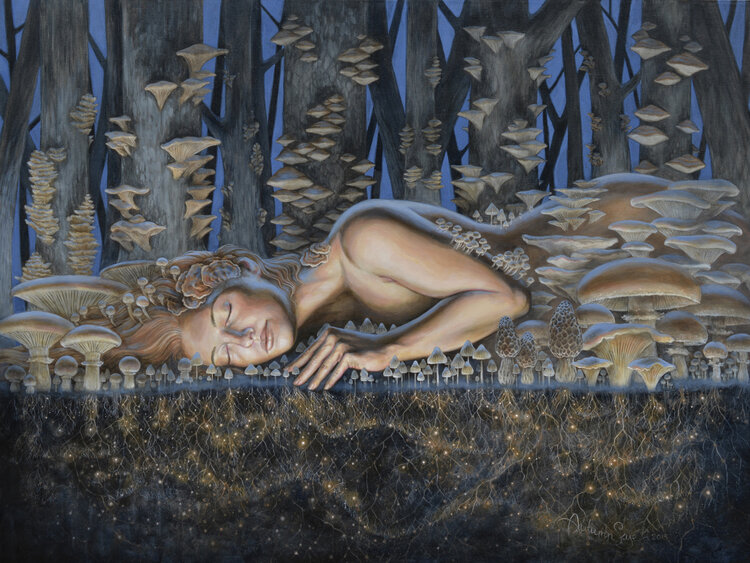By Sheyna Haisman-Holmes
Happy Solstice! Today, December 21st is the winter solstice which means that it’s the shortest day and the longest night of the year. It is the new moon on the 23rd, really driving this dark time of the year home! The winter solstice marks the returning of the sun, which grows a little bit more each day. Daylight hours will keep extending up until the summer solstice in June, where the sun will then start to lessen each day. Although this day marks the returning of the sun, it also marks the beginning of winter. The liminal space from the winter solstice to the New Year can be a time of deep reflection. Tamas is a concept that ties in with this time of year and provides guidelines and depth to the energies that are present during the winter.
This is a very special time of year and it is celebrated across many cultures. Aside from the winter solstice, there is Kwanzaa (African American & Pan-African), Chanukah (Jewish), Christmas (Christian), Soyal (Hopi), Shalako (Zuni), Yalda (Iran), Dong Zhi (China), Makara Sankranti (India), Saturnalia (Roman), Toji (Japan), Jul/Yule, and more. There are many celebrations and festivals at this time of year to celebrate the returning of the sun. The celebrations often last multiple days, such as Yule, which goes from December 21st to January 1st. During this time, there are many rituals that can be done like setting intentions for the year ahead, dreaming, self Abhyanga, crafting, resting, lighting candles and sitting by the fire.
In Ayurveda, there are the 3 Gunas or the 3 universal qualities: Sattva, Rajas and Tamas. Sattva is purity, consciousness, spiritual purpose and right intentions. Rajas is movement, energy and change. Tamas is inertia and darkness. This time of the year mirrors tamas energy with the weather drawing us inside, the leaves falling to cover the ground and the mycelium composting the forest floor. Tamas is a combination of earth and water elements and is present during winter and early spring. Tamas brings on sleep, inaction, laziness, gloominess, etc. With tamas, the potential energy that’s available is darkness; that which dances with composting and destruction.
Tamas is relevant in different facets of the wild and within our bodies. Just as the trees loose their leaves and put their energy inwards in the winter, we are energetically going within as well. Just as the wild does, we need sleep, rest and darkness to regenerate. Rest isn’t always integrated in a healthy way in our culture, but wintertime is the season for rest. Just as each day has a season or time for eating, sleeping and working, so does the year. We can rejoice in the knowing that rest is a necessary part of life that isn’t only deserved before of after being highly productive.
An uncommon thread in our culture (that is very much alive nonetheless) is the embrace of darkness. We talk about the concept of light and dark, and must have both to be able to perceive the other. We often stay awake way past sundown, keeping lights on inside our homes. We may travel to warm places in the winter and be eager for summertime adventures to begin. In January, we start the New Year where our culture promotes New Years resolutions and an active energy of a fresh start, yet we are still in the depths of introversion. We can begin to dream and plan what we want to emerge as in the springtime. Like the trees, we are using the leaf litter at our feet to compost and regenerate our brilliance. The darkness of this time is not to be feared, but is the pause at the bottom of an exhale before a big slow inhale as the sun returns each day.
Tamas is a quality that can often show up in the mind as confusion, not knowing, mental fog and sadness. It can show up as attachments, loneliness, depression, excessive sleep and anger. These qualities can manifest from eating tamasic foods, being inactive, eating unhealthy foods, sleeping a lot, not getting enough sun and not engaging in a healthy routine or lifestyle. Tamas in the mind can increase during the winter, so we want to incorporate more sattva to balance. Tamas is the opposite of sattva and like increases like & opposites balance. Below are some examples of tamasic and sattvic foods:
Tamasic foods: avocado, plums, watermelon, mushrooms, garlic, onion, pumpkin, wheat, brown rice, beans, cheese, peanuts, jalapeno, nutmeg, molasses, sodas, stevia, alcohol, marijuana, beef, pork, lamb. These foods make the mind dull and heavy.
Sattvic foods: pomegranate, dates, figs, sweet potato, squash, basmati rice, quinoa, mung beans, ghee, almonds, cashews, cardamom, turmeric, fennel, jaggary, raw honey.
Eating seasonally usually helps us keep balance with the seasonal doshas. For example, nourishing squashes grow in fall which help to nourish Vata dosha. Ayurveda says that eating mushrooms can cause darkness, inertia and mental fog, but they also grow in this winter season. Tomatoes, which are pitta elevating, grow in summertime which is pitta season. We can still eat our freshly foraged chanterelles and dry farmed tomatoes, but in a healthy moderation. All we have to remember is that like increases like and we can use opposing qualities to create balance in our bodies.
May we embrace this time of year with eating balanced foods, getting sunshine when possible, slowing down to embrace the dark days and composting old parts of ourselves that no longer serve us. Happy Winter Solstice and New Year to you all! 🙂
Art By: www.autumnskyeart.com @autumnskyeart
12/21/22
